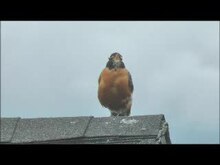From Wikipedia, the free encyclopedia
| American robin | |
|---|---|
 |
|
| Male | |
| Scientific classification | |
| Kingdom: | Animalia |
| Phylum: | Chordata |
| Class: | Aves |
| Order: | Passeriformes |
| Family: | Turdidae |
| Genus: | Turdus |
| Species: | T. migratorius |
| Binomial name | |
| Turdus migratorius Linnaeus, 1766 |
|
 |
|
| Breeding range Year-round range Wintering range | |
| Synonyms | |
|
Merula migratoria Planesticus migratorius |
|
Male sings
The American robin is active mostly during the day and assembles in large flocks at night. Its diet consists of invertebrates (such as beetle grubs, earthworms, and caterpillars), fruits, and berries. It is one of the earliest bird species to lay eggs, beginning to breed shortly after returning to its summer range from its winter range. Its nest consists of long coarse grass, twigs, paper, and feathers, and is smeared with mud and often cushioned with grass or other soft materials. It is among the first birds to sing at dawn, and its song consists of several discrete units that are repeated.
The adult robin is preyed upon by hawks, cats, and snakes, but when feeding in flocks, it can be vigilant and watch other birds for reactions to predators. Brown-headed cowbirds lay eggs in robin nests (see brood parasite), but robins usually reject the cowbird eggs.




No comments:
Post a Comment